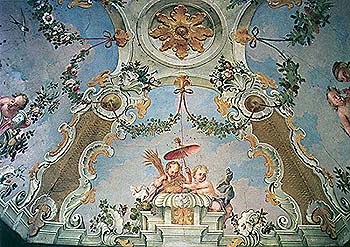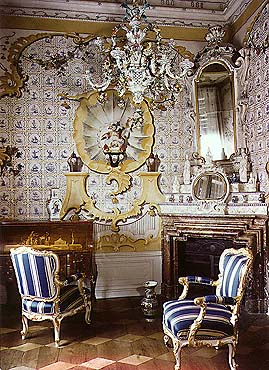Český Krumlov Castle in the Baroque Period
 In 1622, the Emperor
Ferdinand II.
von Habsburg donated the dominion of Český Krumlov to his
financier Johann Ulrich
von Eggenberg (1568-1634) for services rendered. Neither Johann
Ulrich nor his son Johann Anton
I. von Eggenberg (1610-1649) settled into Czech environment or
made their seat in Krumlov. However, the Eggenbergs were in the
Emperor\'s favour at that time and received many honours. In 1623,
the Eggenbergs
were raised to the estate of imperial princes; in 1625 they were
given the so-called great palatinate - among others the right to
coinage - and in 1628 the Krumlov dominion became a principality
holding the title of Duchy. It was not until the rule of Johann
Christian I. von Eggenberg (1641-1710) and his sophisticated
wife Marie
Ernestine von Eggenberg (1649-1719) that the Český Krumlov
Castle became the residential seat of the family. They were
particularly fond of theatre and music but they also took interest
in visual arts and the castle library. At first, plays were
performed in the castle\'s Deer Hall (today\'s Masquerade Hall) and
in 1689, a separate theatre building with a permanent ensemble
began its operation behind the Cloak Bridge next to the so-called
Renaissance House (Eggenberg
Castle Theatre in the 17th century).
In 1622, the Emperor
Ferdinand II.
von Habsburg donated the dominion of Český Krumlov to his
financier Johann Ulrich
von Eggenberg (1568-1634) for services rendered. Neither Johann
Ulrich nor his son Johann Anton
I. von Eggenberg (1610-1649) settled into Czech environment or
made their seat in Krumlov. However, the Eggenbergs were in the
Emperor\'s favour at that time and received many honours. In 1623,
the Eggenbergs
were raised to the estate of imperial princes; in 1625 they were
given the so-called great palatinate - among others the right to
coinage - and in 1628 the Krumlov dominion became a principality
holding the title of Duchy. It was not until the rule of Johann
Christian I. von Eggenberg (1641-1710) and his sophisticated
wife Marie
Ernestine von Eggenberg (1649-1719) that the Český Krumlov
Castle became the residential seat of the family. They were
particularly fond of theatre and music but they also took interest
in visual arts and the castle library. At first, plays were
performed in the castle\'s Deer Hall (today\'s Masquerade Hall) and
in 1689, a separate theatre building with a permanent ensemble
began its operation behind the Cloak Bridge next to the so-called
Renaissance House (Eggenberg
Castle Theatre in the 17th century).
Johann Christian and his wife had the whole complex of the castle residence adapted according to the fashion of the period. The founding of the Castle Baroque Park according to designs by Jakub de Maggi and Petr Spineta dates at the end of the 17th century. The reconstruction of the Upper Castle (Castle No. 59 - Upper Castle) was also carried out. Large-scale adaptations as well as enlargement of the interiors were made. Each storey was levelled out to unify halls to the same level, and massive Baroque staircases were built. The original square Gothic tower was taken down and a new wooden Cloak Bridge was founded. The building of the Mint (Castle No. 59 - Mint) enriched the IInd courtyard.
 Because the male side of
the family died out, Princess Marie Ernestine, Johann Christian\'s
widow, left the property to her nephew Prince Adam Franz zu
Schwarzenberg (1680-1732) who took it over in 1719. Through the
merger of the Eggenbergs\' and Schwarzenbergs\' property an
extensive dominion was created which was reminiscent of the
Rosenberg era in its size. Concerning the personality of Adam
Franz, the dominion fell into the hands of a real Baroque cavalier,
a man who was successful at the imperial court as well as a
generous patron and passionate hunter. The dominion of Český
Krumlov again received the title of Duchy (1723). His career was at
its peak when Adam Franz met his death through an "accidental"
bullet wound from the gun of Emperor Charles VI. during a hunt near
Brandýs nad Labem (1732) (see Imperial
Hunt). The Duke Joseph Adam zu
Schwarzenberg (1722-1782) under the guardianship of his mother
Eleonora Amalie von Lobkowicz took charge of the property. Joseph
Adam also achieved rapid political and social growth at the
imperial court. Perception and enjoyment of the courtly atmosphere
as well as creativity typical of the culmination of the Baroque and
Rococo periods resulted in far-reaching architectural remodellings
of the Krumlov residence. In addition to the reconstruction of the
St.George\'s
Castle Chapel and the addition of another storey of the castle
residence, the Upper Castle boasted new designs in the splendid
Masquerade
Hall and Mirror Hall (History
of the Hall of Mirrors). The Masquerade Hall was adorned with
delightful paintings by Josef Lederer while the decoration of the
Mirror Hall was the work of two Viennese painters, Hans Wetschl and
Leo Märkl. Both halls were part of an extensive complex that had
been designed for entertainment and enjoyment. Concerts used to
take place in the Mirror Hall whereas the Masquerade Hall was used
to hold balls and masquerade parties. The wooden corridor of the
Cloak Bridge led directly from the Hall into the remodelled
Castle
Theatre in Český Krumlov. Prince Joseph Adam zu Schwarzenberg
had the old building of the Eggenbergs\' theatre rebuilt and
furnished with a vast range of scenes and wings, costumes, stage
props and theatricals. The Connecting
Corridor led to the ingenious bush labyrinth in the
Because the male side of
the family died out, Princess Marie Ernestine, Johann Christian\'s
widow, left the property to her nephew Prince Adam Franz zu
Schwarzenberg (1680-1732) who took it over in 1719. Through the
merger of the Eggenbergs\' and Schwarzenbergs\' property an
extensive dominion was created which was reminiscent of the
Rosenberg era in its size. Concerning the personality of Adam
Franz, the dominion fell into the hands of a real Baroque cavalier,
a man who was successful at the imperial court as well as a
generous patron and passionate hunter. The dominion of Český
Krumlov again received the title of Duchy (1723). His career was at
its peak when Adam Franz met his death through an "accidental"
bullet wound from the gun of Emperor Charles VI. during a hunt near
Brandýs nad Labem (1732) (see Imperial
Hunt). The Duke Joseph Adam zu
Schwarzenberg (1722-1782) under the guardianship of his mother
Eleonora Amalie von Lobkowicz took charge of the property. Joseph
Adam also achieved rapid political and social growth at the
imperial court. Perception and enjoyment of the courtly atmosphere
as well as creativity typical of the culmination of the Baroque and
Rococo periods resulted in far-reaching architectural remodellings
of the Krumlov residence. In addition to the reconstruction of the
St.George\'s
Castle Chapel and the addition of another storey of the castle
residence, the Upper Castle boasted new designs in the splendid
Masquerade
Hall and Mirror Hall (History
of the Hall of Mirrors). The Masquerade Hall was adorned with
delightful paintings by Josef Lederer while the decoration of the
Mirror Hall was the work of two Viennese painters, Hans Wetschl and
Leo Märkl. Both halls were part of an extensive complex that had
been designed for entertainment and enjoyment. Concerts used to
take place in the Mirror Hall whereas the Masquerade Hall was used
to hold balls and masquerade parties. The wooden corridor of the
Cloak Bridge led directly from the Hall into the remodelled
Castle
Theatre in Český Krumlov. Prince Joseph Adam zu Schwarzenberg
had the old building of the Eggenbergs\' theatre rebuilt and
furnished with a vast range of scenes and wings, costumes, stage
props and theatricals. The Connecting
Corridor led to the ingenious bush labyrinth in the
 Castle
Gardens in Český Krumlov. The park was provided with new
cascade fountain, decorated with statues of water deities by
sculptor Josef M. Grissler from 1765. In the course of 1755-1757,
the Summer Manor Bellarie was rebuilt, while in 1752 a wooden
bandstand decorated by František
Jakub Prokyš. was established at the back of the park. The end
of the park was covered by a large pond that supplied the water
machine in the nearby Little
Bird Castle with water. The park passed into a wide boulevard
leading towards the Kvítek Dvůr which was remodelled in Rococo
style in the years 1750-1752. Between 1744-1746 the winter Castle
Riding Hall (Castle
No. 178 - Castle Riding School) was built near the castle
according to a project by Andreas Altomonte. At the end of the 18th
century building activities in the castle came to a close.
Castle
Gardens in Český Krumlov. The park was provided with new
cascade fountain, decorated with statues of water deities by
sculptor Josef M. Grissler from 1765. In the course of 1755-1757,
the Summer Manor Bellarie was rebuilt, while in 1752 a wooden
bandstand decorated by František
Jakub Prokyš. was established at the back of the park. The end
of the park was covered by a large pond that supplied the water
machine in the nearby Little
Bird Castle with water. The park passed into a wide boulevard
leading towards the Kvítek Dvůr which was remodelled in Rococo
style in the years 1750-1752. Between 1744-1746 the winter Castle
Riding Hall (Castle
No. 178 - Castle Riding School) was built near the castle
according to a project by Andreas Altomonte. At the end of the 18th
century building activities in the castle came to a close.
The Baroque interiors evoking a period atmosphere are included in the No.I Guided Tour of Český Krumlov Castle and open to the public.
See also :
History of
Český Krumlov Castle
Český
Krumlov Castle in the 19th century
(mh)

